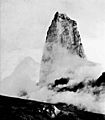Eruption facts for kids
Eruption means "breaking out" or bursting forth. This word comes from Latin. We often use it to describe when something suddenly pushes out from inside.
The most common type of eruption we hear about is a Volcanic eruption. This is when hot melted rock, ash, and gases burst out from a volcano. But "eruption" can also mean other things, like when a tooth pushes through your gums for the first time.
Contents
What is an Eruption?
An eruption is a sudden and forceful release of something. Think of it like a big sneeze or a balloon popping! When we talk about eruptions, we usually mean natural events. The most exciting and powerful eruptions happen with volcanoes.
Volcanic Eruptions: When Volcanoes Wake Up
A volcanic eruption happens when a volcano becomes active and releases material. This material can be hot liquid rock called lava, tiny pieces of rock and glass called volcanic ash, or even gases. These eruptions can be very different from one another. Some are gentle, while others are incredibly explosive.
Different Kinds of Eruptions
Volcanoes don't all erupt in the same way. Scientists give different names to volcanic eruptions based on how they behave.
Explosive Eruptions
Some eruptions are very powerful and explosive. A Plinian eruption is one of the most violent types. It sends a huge column of ash and gas high into the sky, sometimes many miles high! This column looks like a giant mushroom cloud. The ash can then fall over a very large area. An example of a volcano known for explosive eruptions is Mount Redoubt in Alaska.
Gentle Lava Flows
Not all eruptions are explosive. Some volcanoes produce more gentle flows of lava.
- Hawaiian eruptions are known for their calm, flowing lava. The lava is very runny and flows like a river. It often creates beautiful, glowing streams of melted rock. Kilauea volcano in Hawaiʻi is famous for these types of eruptions.
- Strombolian eruptions are a bit more active than Hawaiian ones. They involve small, regular explosions that throw out glowing chunks of lava. These eruptions are often called "fireworks" because they create bright arcs of lava in the sky. Stromboli volcano in Italy is a classic example.
What Comes Out of a Volcano?
When a volcano erupts, several things can come out:
- Lava: This is melted rock that flows out of the volcano. When it cools, it turns into solid rock. There are different types of lava, like pahoehoe which looks ropy when it cools.
- Ash: Volcanic ash is made of tiny pieces of rock, minerals, and volcanic glass. It's not like ash from a fire; it's sharp and abrasive. Ash clouds can travel far and cause problems for breathing and machinery.
- Gases: Volcanoes release many gases, including water vapor, carbon dioxide, and sulfur dioxide. These gases can be dangerous.
- Lahars: Sometimes, volcanic ash and rock mix with water from rain or melted snow. This creates fast-moving mudflows called lahars. Lahars can be very destructive, burying towns and changing landscapes. The 1985 eruption of Nevado del Ruiz in Colombia caused deadly lahars that destroyed the town of Armero.
Famous Volcanoes and Their Eruptions
Many volcanoes around the world have had famous or devastating eruptions:
- Tavurvur in Papua New Guinea is an active volcano known for its frequent eruptions.
- Mayon Volcano in the Philippines is famous for its perfect cone shape and has had many eruptions, including dangerous pyroclastic flows. Pyroclastic flows are fast-moving currents of hot gas and volcanic debris.
- Mount Pelée in Martinique had a catastrophic eruption in 1902 that destroyed the city of Saint-Pierre. After the eruption, a huge lava spine grew out of its crater.
- Mount Lamington in Papua New Guinea also had a devastating eruption in 1951.
- Surtsey is a new island that formed off the coast of Iceland in 1963 due to an underwater volcanic eruption.
- The 1886 eruption of Mount Tarawera in New Zealand created a large fissure, or crack, in the ground.
Other Types of Eruptions
While volcanoes are the most dramatic example, the word "eruption" is also used in other ways. For instance, when a baby's first tooth pushes through their gums, it's called a tooth eruption. It's a much smaller and gentler "breaking out" than a volcano!
Images for kids
-
An example of the lava arcs formed during Strombolian activity. This image is of Stromboli itself.
-
Tavurvur in Papua New Guinea erupting
-
21 April 1990 eruptive column from Redoubt Volcano, as viewed to the west from the Kenai Peninsula
-
Lahar flows from the 1985 eruption of Nevado del Ruiz, which totally destroyed Armero in Colombia
-
Pyroclastic flows at Mayon Volcano, Philippines, 1984
-
The fissure formed by the 1886 eruption of Mount Tarawera, an example of a fracture zone eruption
See also
 In Spanish: Erupción volcánica para niños
In Spanish: Erupción volcánica para niños













